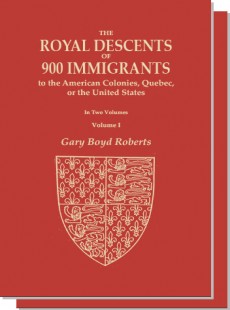
By Gary Roberts
RD 900 differs fundamentally from the series of volumes by David Faris and Douglas Richardson (1996-1999, 2004-2013), Plantagenet Ancestry, Magna Charta Ancestry and Royal Ancestry. Faris-Richardson cover in lavish detail all (or certainly most) Plantagenet or Magna Carta descendants, a few more than 250 17th– (and a very few 18th) – century immigrants. The biographical and bibliographical detail in these works is splendid, often overwhelming (especially Richardson’s volumes), and requires some knowledge of medieval sources to discern which references to check. RD 900 covers four centuries of immigration—not simply the 17th and 18th, and covers 900 immigrants, not merely 250. Many immigrants in RD 900 are from European countries, not just Great Britain, and some of the 900 are living figures whose immigration was in the 20th century. Author Gary Boyd Roberts was able to cover such a large number because RD 900 is basically an outline, not of all Plantagenet descents, but of only the “best” Plantagenet (or earlier royal) descent from the most recent king, for each of the 900. Mr. Faris did not include the many immigrant descendants of the illegitimate children of kings Henry II and John of England (much less Henry I of England or William the Lion of Scotland); the inclusion of such descendants considerably expanded the work of both Roberts and Richardson. Richardson chose to cover almost exclusively 17th-century immigrants because each may have millions of American descendants, some of whom join hereditary societies based on the descents outlined therein. Mr. Roberts’ work extensively cites the 2013 volumes by Richardson, which expanded those of Faris (and those of Faris expanded much of the previous work of Frederick Lewis Weis and Walter Lee Sheppard, Jr.—Ancestral Roots and Magna Carta Sureties, published in several editions over a generation). Richardson covers only a few descents on the European continent, most treating other lines of Plantagenet kings. Mr. Roberts also cites a large number of continental European sources (French, German, Swedish, Italian, etc.), and includes French Canada, where a recent flowering in the periodical literature has developed royal descents for over 20 immigrants from France to Quebec. French-Canadian scholars, including several who worked with Mr. Roberts, found descendants of those Quebec settlers who came to the U.S., largely in the 19th– or 20th centuries, and include or were forebears of various political and entertainment figures well known today.
The Faris and Richardson works concentrate on colonial immigrants from Great Britain to the American colonies. Mr. Roberts entends the scope of these works both geographically and chronologically, and his work offers an illuminating view of the evolution of European-derived peoples overall. Mr. Roberts certainly depends on the Richardson works for the first eight or ten generations of many post-17th century immigrants, and consolidates the work of over 250 scholars of the last two or three generations. Readers should probably own both Mr. Richardson’s 2013 five-volume set, and RD 900 (in two volumes). By owning both they will know the sources that document their own royal descents and also begin to understand the complexity and extent of European/British/American/French Canadian kinship. The Faris and Richardson achievements were magnificent for their specific purpose of linking current Americans to royalty via 17th-century colonists. Many readers, especially long-time GPC customers, may own one or two editions of the Weis and Sheppard volumes, the first Faris book, and the first editions of Plantagenet Ancestry and Magna Charta Ancestry by Mr. Richardson. Many will also own copies of RD 500 and RD 600 by Mr. Roberts. From these series, one can follow the progress of royal descent literature during the past 50 years. This literature has massively enlarged the field, corrected hundreds of lines, and appeared frequently in journals. All these authors (and even Roderick Stuart in Royalty for Commoners) attempted up-to-date surveys that became larger and larger as microfilm/microfiche, the Internet, and transcriptions of English documents have virtually exploded. These authors also acted as a kind of clearinghouse for many other contributors who sent the authors private research or early versions of material later published.
RD 900, especially, introduces the reader to much of the full gamut of European genealogical evolution. This evolution, because of surviving sources, is largely downward, from kings to nobles to gentlemen/lairds/seigneurs/etc. through early modern landowners, bureaucrats, soldiers, clergymen, and colonial settlers, to many of the recent leaders of American, British, and European culture. Included among these figures would be intellectual leaders, political and literary figures, scientists, men of business, and persons from the suburban middle class. All of these latter are distant kinsmen of each other, of European royal families, of various British prime ministers and American presidents, of various aristocratic leaders of the French Revolution, of many of the noble von founders of modern Prussia and Germany, of Austrian diplomats, of Russian writers such as Tolstoy and Nabakov, of Italian popes, of leaders in the once large Spanish Empire, of heroes in Low Country resistance to the “Spanish Netherlands,” and of kings and generals responsible for Swedish expansion during the 30 Years War. Figures from all of these groups appear in RD 900. Mr. Roberts also covers the lines from RD immigrants to all U.S. presidents of such descent, and among modern First Ladies, RDs for Bess Truman, Mamie Eisenhower, Jacqueline Kennedy, Betty Ford, Rosalynn Carter, Nancy Reagan, and Barbara and Laura Bush. Another group of surprising figures in RD 900 are English authors distantly related to all Americans of royal descent– Sir Francis Bacon, David Hume, John Dryden, Jonathan Swift, Henry Fielding, James Boswell, Horace Walpole, Jane Austen,, Anthony Trollope, Robert Louis Stevenson, Lord Byron, P.B. Shelley, Matthew Arnold, Aldous Huxley, George Orwell, Bertrand Russell, Evelyn Waugh, W.H. Auden, Christopher Isherwood, J.M. Synge, and Noel Coward, among others. French-Canadian descendants, often very contemporary include Jack Kerouac, Robert Goulet, Angelina Jolie, Madonna, Mark Wahlberg, Celine Dion, Ryan Gosling, Anna Paquin, Justin Bieber, and Beyoncé.
For mind-expansion and sheer fun, plus its bibliography, Mr. Roberts’ work should find a wide audience. Richardson, Faris, and Weis and Sheppard are certainly the first sources for dates and biography. Richardson’s list of references is learned and voluminous. Mr. Roberts’ bibliography is pointed, usually one major source per family and ten or fewer sources per chart. All of these authors have written for GPC (now Genealogical.com), publishers of all editions of Weis and Sheppard, the first editions of Faris and Richardson, and RD 500, RD 600, and RD 900 by Mr. Roberts, who thinks this field, still expanding, has been splendidly summarized—and updated, from the 1950s, through the publication dates of these books.
Millions of Americans have royal descent. Once readers have traced much of their American ancestry, a quick check of immigrant names in RD 900 will tell you which ancestors were descendants of kings, outline the best descent of each RD immigrant forebear, and then allow you to explore kinships to hundreds of historical figures. The works of Richardson, Faris, and Weis and Sheppard then add biography and additional royal lines for many immigrants.
POSTSCRIPT
RD 900 is also surprisingly up to date. Boris Johnson, the new British Prime Minister, appears on p. 12; at the time of publication he is noted as Foreign Secretary. In addition to descent from kings of Wurttemberg and Great Britain, the new Prime Minister is also descended from Mrs. Elizabeth Alsop Baldwin (Fowler) of Milford, Connecticut, charted on pp. 588-589. This last was a descendant of Edward I, King of England, and a cousin of Queens Anne Boleyn and Elizabeth I. The line from Mrs. Baldwin to First Lady Mamie Eisenhower appears on p. 589. Other descendants of Mrs. Baldwin will be discussed in a future article in “Genealogy Pointers.”





